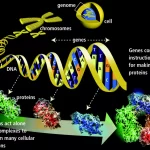
Bioinformatics glossary – Y
November 16, 2018A | B | C | D | E | F | G | H | I | J | K | L | M | N | O | P | Q | R | S | T | U | V | W | X | Y | Z
Bioinformatics glossary – Y

Y chromosome
One of the two sex chromosomes, X and Y.
Yeast 2-hybrid system
A yeast-based method used to simultaneously identify, and clone the gene for, proteins interacting with a known protein. The basis of this method is a “transcriptional reporter assay” (see definition) in which reporter gene expression is dependent on two domains. The first domain is linked to the known protein. The second domain is genetically linked to a library. If the library is screened against the known protein the two domains will interact only if a protein from the library binds the known protein, resulting in transcription activation of the reporter gene, and a blue color. The “blue yeast clone” will contain the gene encoding the newly identified protein.
YAC
Yeast artificial chromosome. This is a method for cloning very large fragments of DNA. Genomic DNA in fragments of 200-500 kb are linked to sequences which allow them to propagate in yeast as a mini-chromosome (including telomeres, a centromere and an ARS – an autonomous replication sequence). This technique is used to clone large genes
and intergenic regions, and for chromosome walking.
Yank
An EMBOSS application. yank is a simple utility to add a specified sequence name to a list file. In fact, it writes out not just the name of the sequence, but also the start and end position of a region within that sequence and, if the sequence is nucleic, it can specify
whether the sequence is the reverse complement. Without the program yank you would need to use a text editor such as pico to create the appropriate list files. yank makes this process easy.
















